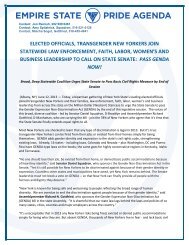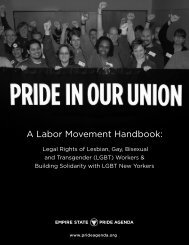Hate Violence against the Lesbian, Gay, Bisexual ... - AVP
Hate Violence against the Lesbian, Gay, Bisexual ... - AVP
Hate Violence against the Lesbian, Gay, Bisexual ... - AVP
Create successful ePaper yourself
Turn your PDF publications into a flip-book with our unique Google optimized e-Paper software.
<strong>Hate</strong> <strong>Violence</strong> Against <strong>Lesbian</strong>, <strong>Gay</strong>, <strong>Bisexual</strong>, Transgender, Queer and HIV-affected Communities in <strong>the</strong> U.S. in 2011NC<strong>AVP</strong>IMMIGRATION STATUSImmigration Status ofSurvivors andVictims,2011O<strong>the</strong>r5%US Citizen73%Undocumented8%Permanent Resident14%n=48973% of survivors and victims who disclosed <strong>the</strong>ir immigration status in 2011 were US citizens, a decrease from 92%in 2010. 14% of survivors and victims were permanent residents in 2011 which reflects an increase from 5% in2010, and 8% were undocumented, which is also an increase from 3% in 2010. Undocumented residents of madeup approximately 4% of <strong>the</strong> total US population in 2011. 11 The over-representation of undocumented survivors andvictims suggests that LGBTQH undocumented people are more vulnerable to hate violence than documentedsurvivors and victims. The number of undocumented survivors and victims may not reflect <strong>the</strong> overall proportionof hate violence survivors and victims as some undocumented survivors and victims are reluctant to reportincidents because of pending legal proceedings or fear of having <strong>the</strong>ir immigration status revealed. Thisoverrepresentation also suggests that NC<strong>AVP</strong> members have built strong relationships with LGBTQHundocumented and immigrant communities.PEOPLE WITH DISABILITIESPeople with disabilities reported more incidents in 2011 than in 2010. In 2011 11% of survivors and victimsreported having a disability, remaining consistent with 2010 (8%). In addition, more survivors disclosed <strong>the</strong>irdisability status in 2011 than 2010, with not disclosed substantially decreasing from 91% in 2010 to 69% in 2011.NC<strong>AVP</strong> members focused on increasing this data in 2011 to give a more in depth picture of <strong>the</strong> intersectionbetween ability and anti-LGBTQH hate violence. Of those who reported disabilities, <strong>the</strong> largest proportion ofsurvivors and victims reported having physical disabilities. However, a sizeable amount of survivors and victimsalso reported mental disabilities. LGBTQH survivors and victims with disabilities can face increased risk of hateviolence in addition to specific barriers to both law enforcement as well as medical assistance in <strong>the</strong> aftermath of anincident of violence. NC<strong>AVP</strong> will continue to document and research <strong>the</strong> intersection of anti-LGBTQH hateviolence and ability to better respond to <strong>the</strong> need of LGBTQH survivors and victims with disabilities.11 Pew Research Center, ―Unauthorized Immigrant Population: National and State Trend 2010‖. Accessed from:http://www.pewhispanic.org/2011/02/01/unauthorized-immigrant-population-brnational-and-state-trends-2010/ on May 15, 2012.27




